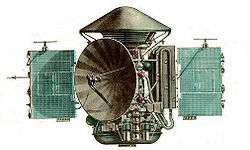Mars Hope
| Mission type | Mars orbiter |
|---|---|
| Operator | Mohammed bin Rashid Space Centre |
| Website | www.emm.ae |
| Mission duration | From 2021 to 2023 (at least).[1] |
| Spacecraft properties | |
| Manufacturer | Mohammed Bin Rashid Space Centre |
| Launch mass | 1500 kg |
| Dimensions | 2.37 m x 2.9 m |
| Power | 600 W solar array |
| Start of mission | |
| Launch date | July 2020[2] |
| Rocket | H-IIA[3] |
| Launch site | Tanegashima LA-Y1[3] |
| Contractor | MHI[3] |
| Orbital parameters | |
| Periareon | 22,000 km [4] |
| Apoareon | 44,000 km [4] |
| Period | 55 h [4] |
| Epoch | Planned |
| Mars orbiter | |
| Orbital insertion | 2021[2] |
| Instruments | |
| EXI (Emirates eXploration Imager), EMIRS (Emirates Mars Infrared Spectrometer), EMUS (Emirates Mars Ultraviolet Spectrometer) | |
The Hope (Arabic: مسبار الأمل) spacecraft orbiter is a planned 2020 unmanned mission to Mars by the United Arab Emirates to study the Martian atmosphere and climate.[1][5][6] The robotic space probe is expected to be launched in the summer of 2020 and to take seven to nine months to arrive at Mars.[1] In designing the orbiter, the Emirates Mars Mission deputy project manager and science lead, Sarah Amiri, is expected to collaborate with the University of Colorado, the University of California, Berkeley and the Arizona State University.[5][6][7]
Concept
The name "Hope" (Arabic: al-Amal) was chosen because "it sends a message of optimism to millions of young Arabs", according to Sheikh Mohammed bin Rashid Al Maktoum, the ruler of the emirate of Dubai for whom the lead space center, the Mohammed Bin Rashid Space Center (MBRSC), of the United Arab Emirates, is named.[6] The project manager is Omran Sharaf.[6] The resulting mission data will be shared freely with more than 200 institutions worldwide.[8]
The Emirates Mars Mission team includes 150 Emirati engineers, with Omran Sharaf as the Project Manager; Sarah Amiri, Deputy Project Manager; Ibrahim Hamza Al Qasim, Deputy Project Manager, Strategic Planning, and Zakareyya Al Shamsi, Deputy Project Manager for the Emirates Mars Mission Operations.[9]
The rocket launcher will be contracted by an unnamed international manufacturer.[5]
Spacecraft
The Hope probe will be compact and hexagonal in shape and structure, weighing about 1,500 kg including fuel. The probe will be 2.37 m wide and 2.90 m tall, the overall size being approximately equivalent to a small car. ‘Hope’ will use three 600-watt solar panels to charge its batteries and it will communicate with Earth using a high-gain antenna with a 1.5m wide dish. The spacecraft will also be equipped with star tracker sensors that will help determine its position in space by studying the constellations in relation to the Sun. Two sets of rocket thrusters and four to six large ‘Delta V’ thrusters, will control the speed of the probe and eight to 12 small Reaction Control System (RCS) thrusters will be responsible for the delicate maneuvering.[10]
The expected travel time of the Hope probe is about 200 days at a speed of up to 40,000 kph on its journey of 60 million kilometres. Upon arrival at Mars, it will study the atmosphere of Mars for two years. Its unique placement in orbit around Mars will provide a new type of data to build "the first truly holistic models" of the Martian atmosphere. The data is expected to provide reasons for the decay of the atmosphere to a level where it is now too thin to allow liquid water to exist.[11] The Hope probe will carry three scientific instruments to study the Martian atmosphere, which include a digital camera for high resolution coloured images, an infrared spectrometer that will examine the temperature patterns, ice, water vapors in the atmosphere, and an ultraviolet spectrometer that will study the upper atmosphere and traces of oxygen and hydrogen further out into space.[12]
Proposed scientific instruments
As of 2015, the conceptual instrument payload is:[4]
- Emirates Exploration Imager (EXI), to measure properties of water ice, dust aerosols and quantify ozone (O3) in the atmosphere.
- Emirates Mars Ultraviolet Spectrometer (EMUS), to measure global characteristics and variability of the thermosphere, and hydrogen and oxygen coronae.
- Emirates Mars Infrared Spectrometer (EMIRS), to measure global thermal structure and abundance of water ice, water vapor and dust in the atmosphere.
See also
References
- 1 2 3 4 Shreck, Adam (May 6, 2015). "UAE to explore Mars' atmosphere with probe named 'Hope'". AP News. Retrieved May 7, 2015.
- 1 2 Staff (May 6, 2015). "Emirates Mars Mission - Video (05:51)". Mohammed Bin Rashid Space Center (MBRSC). Retrieved May 7, 2015.
- 1 2 3 https://twitter.com/HopeMarsMission/status/712181212316614656. Retrieved 22 March 2016. Missing or empty
|title=(help) - 1 2 3 4 Staff (May 7, 2015). "UAE Unveils Mission Plan for the First Arab Space Probe to Mars". Ministry of Cabinet Affairs. SpaceRef. Retrieved May 9, 2015.
- 1 2 3 Jones, Rory; Parasie, Nicolas (May 7, 2015). "U.A.E. Plans to Launch Mars Probe - Scientists behind Emirati orbiter 'Hope' aim to collect data on the Red Planet". Wall Street Journal. Retrieved May 7, 2015.
- 1 2 3 4 Berger, Brian (May 6, 2015). "UAE Unveils Science Goals for 'Hope' Mars Probe". SpaceNews. Retrieved May 7, 2015.
- ↑ Bell, Jennifer (April 9, 2015). "UAE and France join hands on space". The National (Abu Dhabi). Retrieved May 28, 2015.
- ↑ Staff (May 7, 2015). "UAE unveils mission plan 'Hope' for first Arab space probe to Mars". Khaleej Times. Retrieved May 7, 2015.
- ↑ "Emirates Mars Mission - Mars Team".
- ↑ "Emirates Mars Mission - Mars Probe".
- ↑ "Gulf News - UAE unveils details of UAE Mars Mission". May 2015.
- ↑ "The National UAE - UAE Mars Mission has a name 'Hope'". May 2015.


.jpg)
.jpg)